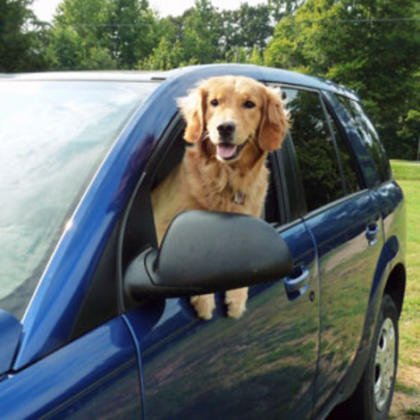9 Ways to Make Vet Visits Easier
Taking your pet to the vet is no fun, or easy, task. But regular visits, even when your furry friend isn't sick, are crucial for the animal's health. Here, Victoria Stilwell, world-renowned pet trainer and star of Animal Planet's TV series It's Me or the Dog, offers tips on how to make the experience less stressful for your pet - and yourself.

1. Handle With Care
Dogs and cats have sensitive areas on their bodies, especially their ears, paws and tummies, which is why pets need to get accustomed to being handled. Try giving your pet a treat or toy while picking up its paw. Repeat this a few times. You want your pet to develop a positive association with being handled, making it easier for the vet to examine the animal, Stilwell says.
2. Create a Cozy Crate
Pet owners often make the mistake of pulling out a crate or carrier only when it's time to go to the vet, which can terrify animals. The solution? Encourage your pet to spend time in its carrier even if you aren't leaving the house. Treat the crate as furniture, setting it up in your pet's favorite spot in the house. Keep the door open and adorn the crate with soft bedding, toys, and treats to entice your pet. If your pet doesn't take to it, consider changing carriers. Your animal may not like the surface or the sounds the door makes. When your cat or dog goes into the carrier on its own, give a cue such as, "We're going on a trip." Pick a phrase that works for you and repeat it every time you want your pet to go inside.
Related: Wacky Dog Behaviors Explained

3. Park & Play
Sit with your pet in a parked vehicle and simply play. After a few days of doing this, turn on the engine and continue to play. Once your animal is used to the sound of a running motor, start driving. Begin with small distances and gradually progress. Remember to place your cat in a carrier and restrain your dog in a crate or seat belt while you drive.
Despite your best attempts, some felines cannot cope with being in the car. Keep your cat in a covered crate (with good airflow) so that he won't be frightened by the outside world. Play calming music to muffle the car noise and spray the crate with facial pheromone such as Feliway. Talk softly and confidently to your cat as you drive to the vet.
4. Make an Appointment to Play
If the only time you saw the doctor were to get a shot, wouldn't you be scared, too? That's why Stilwell recommends going to the vet for supervised playtime. "Your pets will associate the vet's environment with a place where they receive love," she says. Although many vets allow this type of visit, check with the office first.
5. Choose a Vet Wisely
Waiting rooms can be stressful places for pets. They can be noisy, and often reek of chemicals and fear hormones from other animals - all of which your pet can detect. If you can find a vet's office that has separate waiting rooms for dogs and cats, that would be ideal. But because most don't offer this luxury, look for one that allows you to take your pet directly into an individual exam room, bypassing the waiting room altogether. Bonus points for a vet who plays music in the exam rooms.
Related: Signs Your Pet is Depressed
6. Tricks of the Trade
Help ease your animal's anxiety with a pacifying scent or wrap. Lavender essence, for instance, may help soothe canines. You can also dress your pup in an anti-anxiety garment, such as the Thundershirt, as "feeling swaddled can calm them," Stilwell says. Although anxiety wraps are available for cats, she doesn't recommend them because felines are less comfortable being confined. Stilwell also recommends playing relaxing, instrumental music in the car. She even created the Canine Noise Phobia CD Series (available at positively.com) which features piano music.

7. Be a Chatty Cathy
No pet owner will call you crazy for talking to your pet, especially when you're at the vet. After all, this may do your pet some good. "Talking to your pets in a calming voice can help relax them," Stilwell says.
8. A Surefire Treat
Treats can be a pet owner's best friend, particularly when trying to soothe your cat or dog. Unless your pet is acclimated to the vet's office, many animals are too scared to eat there. The trick? Warm a hot dog or tuna right before you leave the house, which will help release scent molecules and make the food hard to resist, even by a nervous animal.
9. Pack a Mat
As if going to the vet weren't bad enough, most animals probably do not appreciate lying on a cold, hard surface. Make the visit more pleasant by bringing a rubber mat. Place it on the exam table for your cat or dog. Your pet will feel more comfortable and won't slide around as much.
How do you make your pet's visit to the vet less stressful? Let me know in the comments!
-By Karen Asp
More from Good Housekeeping:
